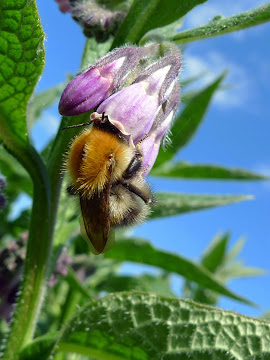Cultivating Comfrey
The comfrey plants I started on my plot last year have really established themselves now and I am beginning to harvest the leaves. This could have been done since April, but I have left it until later so that the bees could find some much appreciated pollen.
Many of you have asked me about these striking looking plants. Comfrey is a herb and greatly valued by many. It has healing properties, is rich in minerals and makes a great animal and plant feed - basically an all-round wonder plant.
The most important thing to remember, especially on an allotment, is to get the right one! Wild comfrey is attractive but seeds very freely whereas I have selected a Russian comfrey cultivar, Bocking 14, which produces very little viable seed and stops it from spreading.
For the gardener, comfrey is an asset as a compost activator but you can also make a liquid feed from it, use it as a fertilising mulch or add it to leaf mould to make potting compost. Comfrey contains the nutrients nitrogen, phosphorus and potassium in higher quantities than either compost or farmyard manure. This is what makes it so valuable as a plant feed.
I have made liquid feed from comfrey in the past but it is very smelly and I'm not intending to make it now that I have such an abundant source of leaves (although I may make some later on to feed my tomatoes). Instead, I am going to add the comfrey direct to my compost heap and use it as a mulch for my potatoes and fruit bushes.
The other really great thing about comfrey is that slugs love it as much as the bees do! I have started to use cut comfrey leaves as a tasty diversion around all my tender plants, removing the leaves and all the attendant slugs every few days.
Add all this to the fact that comfrey is really easy to grow - just add a good feed of manure in the autumn - and also acts as a wind-break for your plot and you can see why I describe it as a wonder plant.
Many of you have asked me about these striking looking plants. Comfrey is a herb and greatly valued by many. It has healing properties, is rich in minerals and makes a great animal and plant feed - basically an all-round wonder plant.
The most important thing to remember, especially on an allotment, is to get the right one! Wild comfrey is attractive but seeds very freely whereas I have selected a Russian comfrey cultivar, Bocking 14, which produces very little viable seed and stops it from spreading.
For the gardener, comfrey is an asset as a compost activator but you can also make a liquid feed from it, use it as a fertilising mulch or add it to leaf mould to make potting compost. Comfrey contains the nutrients nitrogen, phosphorus and potassium in higher quantities than either compost or farmyard manure. This is what makes it so valuable as a plant feed.
I have made liquid feed from comfrey in the past but it is very smelly and I'm not intending to make it now that I have such an abundant source of leaves (although I may make some later on to feed my tomatoes). Instead, I am going to add the comfrey direct to my compost heap and use it as a mulch for my potatoes and fruit bushes.
The other really great thing about comfrey is that slugs love it as much as the bees do! I have started to use cut comfrey leaves as a tasty diversion around all my tender plants, removing the leaves and all the attendant slugs every few days.
Add all this to the fact that comfrey is really easy to grow - just add a good feed of manure in the autumn - and also acts as a wind-break for your plot and you can see why I describe it as a wonder plant.
Submitted by Jane, plot 9

Comments
Post a Comment